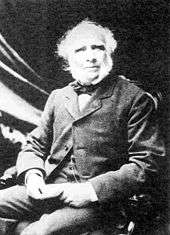Robert Reid Kalley

Robert Reid Kall September 1809 – 17 January 1888) was a Scottish physician and Presbyterian missionary notable for his efforts to spread Presbyterian views in Portuguese-speaking territories and as the introducer of Protestantism in Portugal at a time when the only religion allowed to the Portuguese citizens was Roman Catholicism.
Biography
Kalley first went to Madeira Island in 1838 with his wife Margaret Crawford, who was ill with tuberculosis. Impressed with the poverty, iliteracy and ignorance of the Madeirans, Kalley exercised Medicine gratituously and decided to teach people to read and to write. He also started to preach, importing translated versions of the Bible in Portuguese from England. He founded a small hospital and several elementary schools. The Catholic Church started to look with worry on these initiatives, since proselytism was forbidden by the Portuguese Constitutional Chart of 1826 and the Bishop of Funchal forbade Kalley's religious lectures in 1841. In 1843, the Bibles he had distributed in Madeira were forbidden, like the meetings at his home. On 8 May 1845 he founded the first Presbyterian Church of Portugal, in Funchal, ordaining presbyters and deacons, and celebrating the Supper of the Lord for 61 Madeiran converts. Since Protestantism wasn't allowed for Portuguese citizens, he faced charges of blasphemy and heresy and all the schools he had founded were closed in 1846. Some converts had to face charges of heresy, then still punished by the death penalty. Kalley sought refuge at the house of the British Counsul and had to leave the island in 1846 in disguise, heading for the United States.[1] His followers were also obliged to leave the island and they took the only offer which was to become labourers in Trinidad.[2]
Kalley was in Malta and later Beirut in 1851 where his first wife died. He met Sarah Poulton Wilson and married her in Torquay on 14 December 1852.[3] Meanwhile, the Protestants who had been driven out of Madeira to work in Trinidad realised that they needed a better home. 150 moved to New York with funding from the American Protestant Society. The Madeira refugees were eventually invited by the people of Jacksonville Illinois, just west of Springfield to make their home in Illinois. One 13 November 1849 they were met with charity and an area of the town became known as Portugues Hill. By 1853 there were about 1,000 Portuguese in Jacksonville.[2] In the year after their marriage they both visited the settlements in Jacksonville and neighboring Springfield, Illinois in
America.[4]
Kalley, biggest work, however, was in Brazil. When Kalley arrived in Brazil in 1854 it had Pedro II as its emperor, and had as is official religion Catholicism. The imperial constitution did not prohibit religious freedom, however, it did prohibit public worship to any form of religion other than Catholicism.
Despite not being the first foreign Protestant missionary in Brazilian soil, Kalley was the one who was the most fruitful among Portuguese-speaking Brazilian. In Rio de Janeiro, he and Sarah founded the Igreja Evangélica Fluminense which is still today the oldest Portuguese speaking church in Brazilian soil, and in Pernambuco, the Igreja Evangélica Pernambucana[5] With his support Sarah created hymnals in Portuguese. She valued singing as a method of spreading the word and she developed ladies meeting's at their new church.[4]
Despite his previous work as a Presbyterian, before coming to Brazil he became convinced of the Congregational values, so the first churches he founded were Congregational churches (like the I. E. Fluminense and I. E. Pernambucana) following the Scottish tradition of closed service. Later, after he developed and founded Congregational churches with a few doctrinal variations (like baptism by immersion) and shaped to the Brazilian culture, which was called locally as Igreja Cristã Evangélica. Crista Evangélica churches became one of the strongest denominations in Brazil until the early 1990s specially in the states of São Paulo (having its hub in São José dos Campos) and Goiás (having its hub in Goiânia and Anápolis).
He often had arguments with the Catholic church and was for a while prohibited from preaching on Brazilian soil.[6]
Kalley became a close friend of Brazil's emperor Pedro II, with whom he often argued against slavery and prohibition of public worship.
He left Brazil in July 1876 and retired to Edinburgh where his expertise was used as a director of the Edinburgh Medical Missionary Society who prioritised medical help as well as missionary zeal. He died at his home, Campo Verde, Tipperlinn Road on 17 February 1888 and he was survived by his wife Sarah. Sarah continued their work and supported the Help for Brazil charity.[4]
References
- ↑ Yates, Nigel (1999). Anglican Ritualism in Victorian Britain, 1830-1910. Oxford: Oxford University Press. p. 144. ISBN 0-19-826989-7, ISBN 978-0-19-826989-2.
- 1 2 When Springfield took in Portuguese refugees, Erika Holst, 24 September 2015, Illinois Times, Retrieved 6 November 2015
- ↑ M. C. Curthoys, ‘Kalley, Robert Reid (1809–1888)’, Oxford Dictionary of National Biography, Oxford University Press, Oct 2009 accessed 31 Oct 2015
- 1 2 3 [M. C. Curthoys, ‘Kalley, Robert Reid (1809–1888)’, Oxford Dictionary of National Biography, Oxford University Press, Oct 2009 accessed 31 Oct 2015] (subscription required)
- ↑ Dobson, David (ed.) (2003). Scots in Latin America. Baltimore, MD: Genealogical Publishing Co. p. 62. ISBN 0-8063-5202-7, ISBN 978-0-8063-5202-2.
- ↑ Pedro, Medeiros. "A Legislação do Brasil Império e a estratégia missionária de Robert Kalley" (PDF). Universidade Federal do Rio de Janeiro.
Further reading
- Kalley, Robert Reid (1844). An Account of the Recent Persecutions in Madeira: In a Letter to a Friend. London: John F. Shaw, 27, Southampton Street, Russell Square.